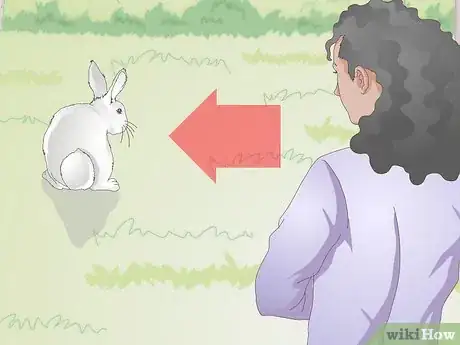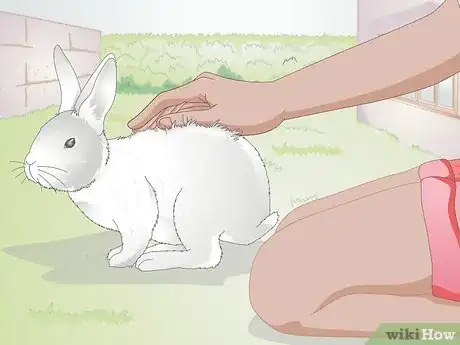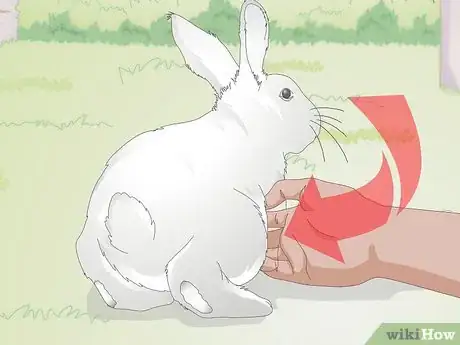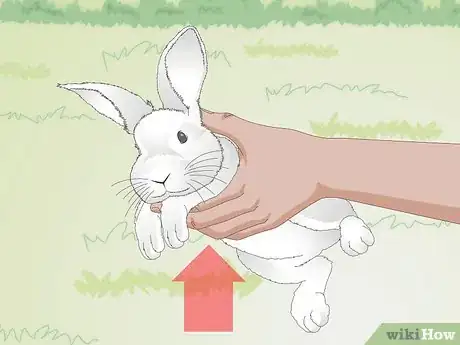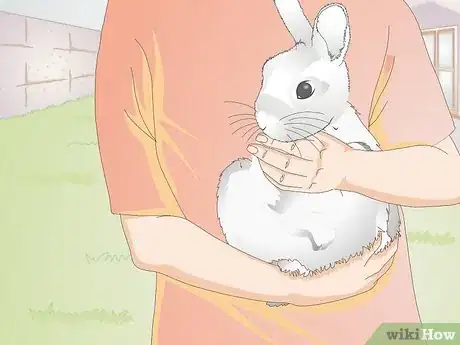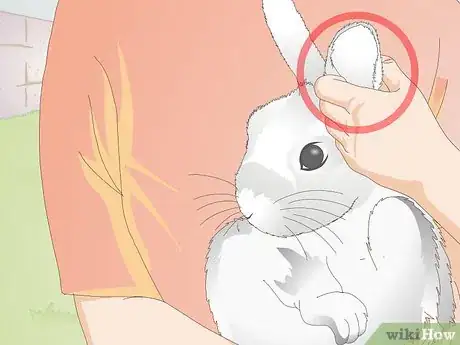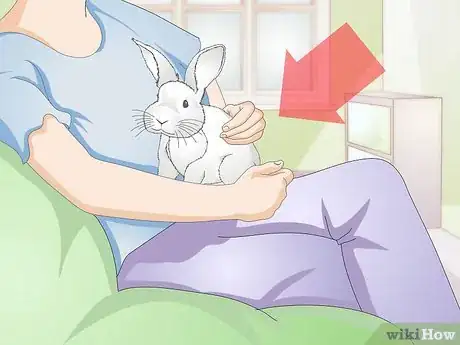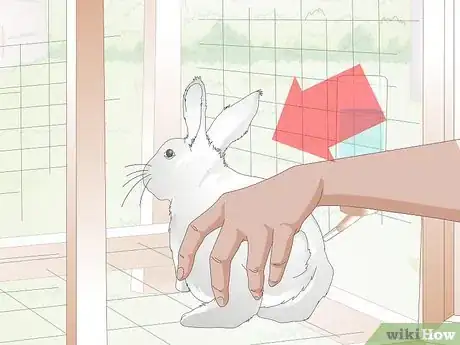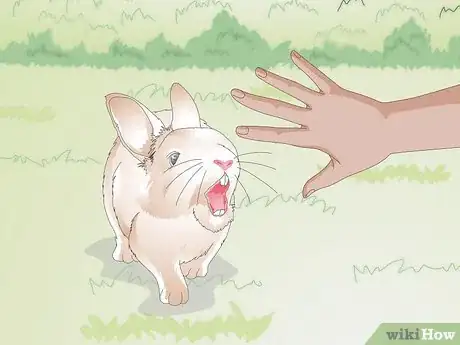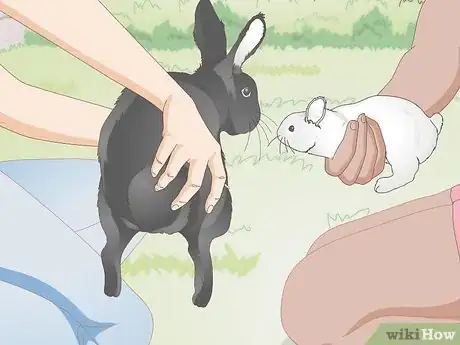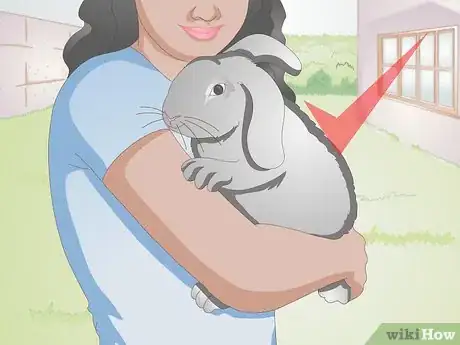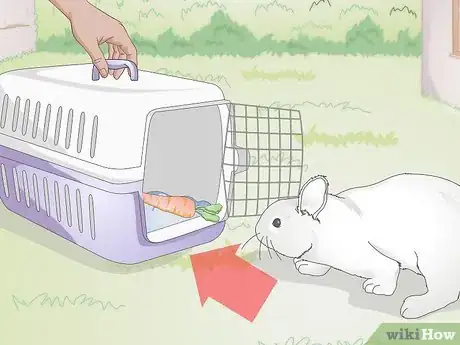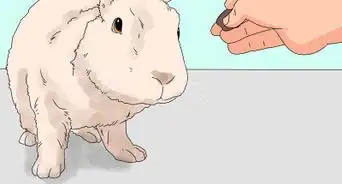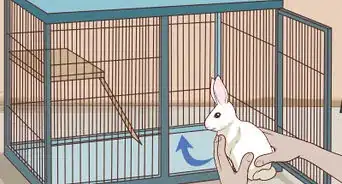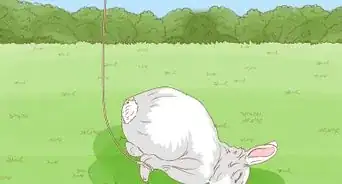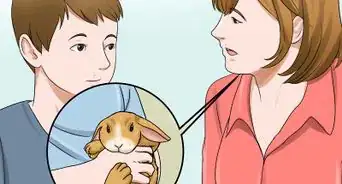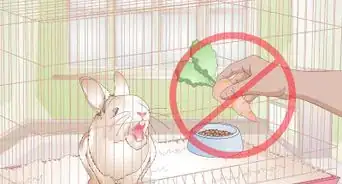This article was co-authored by Pippa Elliott, MRCVS. Dr. Elliott, BVMS, MRCVS is a veterinarian with over 30 years of experience in veterinary surgery and companion animal practice. She graduated from the University of Glasgow in 1987 with a degree in veterinary medicine and surgery. She has worked at the same animal clinic in her hometown for over 20 years.
wikiHow marks an article as reader-approved once it receives enough positive feedback. In this case, 89% of readers who voted found the article helpful, earning it our reader-approved status.
This article has been viewed 228,694 times.
Rabbits are a common pets and make great companions. They come in a variety of sizes and colors and enjoy human interaction. Part of caring for a rabbit is picking it up and holding it. However, there are many rabbits that need help being comfortable with human handling.
Steps
Picking Up
-
1Familiarize yourself. Before holding a rabbit for the first time, it is best to let the rabbit get used to you.[1]
- Get comfortable. If the rabbit's cage or hutch is on the ground, sit next to it. Height can often be intimidating to smaller animals and sitting down reduces height and can make you seem less intimidating.
- Don't rush. Put your hand beside the rabbit's hutch or cage and encourage it to sniff you. Hold your hand there a few moments, speaking in soft, reassuring tones like you would with a human who may be frightened or uncomfortable.
- Offer a treat. If the rabbit shows no signs of aggression, take a treat like lettuce or carrot, and put your hand inside the cage or hutch. Don't force the treat on the rabbit, but bring your hand close enough so it can smell the treat. A friendly rabbit will have no problem taking the treat from you.
- Understand shyness. Just like some people, there are extroverted rabbits and introverted ones. Shyness doesn't mean the rabbit is aggressive or doesn't like you; it may just take longer for this rabbit to get to know you.
-
2Attempt to pet the rabbit. If you've given the rabbit a treat and it does not show signs of aggression or fear, pet the rabbit. Pet in long, slow strokes from the shoulders down towards the flank, stopping at the top of the hip. Avoid touching the rabbit's head because this is what a predator would do and the rabbit might not like it.
- If the rabbit seems friendly, but hasn't moved toward you, curl your fingers under your hand, making it seem smaller and less threatening. Using the back of your hands or fingers, lightly stroke the top of the rabbit's shoulder or flank.
Advertisement -
3Slide your hand under the rabbit's armpits. You want to pick the rabbit up in such a way that you are supporting the weight of its body at all times. The first step is sliding your dominant hand, palm up, under the rabbit's armpits, gently positioning your hand like a cradle. You'll want your hand to rest behind the elbows, but snug against the back of the forelegs.
-
4Lift and scoop. In one motion, you'll lift the rabbit with your dominant hand, while scooping under the rear and back legs with the other. Don't worry if it doesn't work the first time. Your rabbit may be skittish, or you may be a little awkward. Be patient, offering treats and pets until the rabbit seems relaxed again. Remember that the key is to lift and support the rabbit's front and back legs at the same time.
- At all times, be ready to gently place the rabbit on the floor or back in the cage. This is in case the rabbit struggles, or tries to leap out of your arms which can cause physical injury.
Holding
-
1Hold the rabbit. Cradling it close to your chest, gently hold the rabbit. Your body acts as a stabilizing force for the rabbit and makes it feel more secure. Sometimes, rabbits will even lean into your chest while you hold them. You can also re-position it a little so that its tummy touches your torso, being sure not to force it onto its back, which can frighten it.
-
2Pet the rabbit. Pat gently with the scooping hand still in place. Rub the rabbit's ears and/or shoulders with the hand under the torso. If the rabbit relaxes, replace the hand holding his torso with the forearm of the hand holding his bottom. Using the hand from the same arm, cradle his chest between his forelegs. This way, the rabbit is in a secure position but can be petted with your other hand.[2]
-
3Sit down with the rabbit. After a while, it may be a good idea to sit down and let the rabbit rest against your torso or lap.
- Find a sofa to sit on, or lean against a wall and gradually slide down until your bottom is on the floor. At this point, you may want to let the rabbit move freely around you and your lap.
- Be sure to pet the rabbit and offer praise. This helps create a positive association with human interaction, as well as being picked up and held. It can also build confidence in shy rabbits.
- Play with the rabbit. If bunnies associate getting picked up with play time, it can make them more comfortable with the process. Build a cardboard house for your rabbit to play in, or let it explore your own house. Set up objects like a bowling alley for the rabbit to knock down. As you get to know the rabbit, it's personality will unfold and you'll know what sorts of games it likes to play.[3]
-
4Put the rabbit back in its cage. When you are done petting the rabbit and letting it explore, pick it up again and gently put it back in its hutch or cage. It may anticipate being put down and start to struggle. Do not drop the rabbit but, at the same time, do not squeeze too firmly as this can cause injury.
- You can teach the rabbit not to struggle by bringing it quickly but gently back against your body. Be patient and repeat this until he sits calmly in your hands until you let go.
- The first time, only expect him to be still for a short moment before you let him go. As soon as he does not struggle, put him down quickly, so he understands that he is to be calm when you set him down.
Adapting to Special Needs
-
1Know the rabbit. Some rabbits adore being picked up and petted. Other rabbits never come around to the idea. Some rabbits will allow themselves to be picked up only by people they trust. If you are new to the rabbit, it's important to ask questions of its owner to determine the temperament of the rabbit before attempting to pick it up.
-
2Consider the size of the rabbit. A tiny baby bunny can be scooped and cradled easily, but what about a 15 to 20 pounds (6.8 to 9.1 kg) rabbit? Consider that these rabbits require greater upper body strength to hold and that it may be more difficult to stabilize their body weight. It is best to carry larger rabbits with their side against your body, letting their fore paws rest on upon the forearm of the hand supporting their torso.[4]
-
3Accommodate elderly rabbits. Rabbits have light bones compared with their body size, and these get more fragile with age. If working with an older rabbit, take into account that you might need to be more gentle or, for health reasons, minimize handling all together.
-
4Work slowly with skittish rabbits. Some rabbits may have had a bad experience in the past with being picked up or held. If you are working with a skittish rabbit that does not like to be held, get it used to the idea of moving with you by putting it in a carrier.[5]
- Put something soft inside the carrier, like a towel or a bunny bed.
- Introduce the carrier gradually, letting the rabbit play with or become familiar with the scent.
- Put food an treats in the carrier so the rabbit associates it with good things. Eventually, your rabbit may hop inside the carrier when it knows you need to move it.
Expert Q&A
Did you know you can get expert answers for this article?
Unlock expert answers by supporting wikiHow
-
QuestionIs a rabbit a good pet for a 13-year-old?
 Pippa Elliott, MRCVSDr. Elliott, BVMS, MRCVS is a veterinarian with over 30 years of experience in veterinary surgery and companion animal practice. She graduated from the University of Glasgow in 1987 with a degree in veterinary medicine and surgery. She has worked at the same animal clinic in her hometown for over 20 years.
Pippa Elliott, MRCVSDr. Elliott, BVMS, MRCVS is a veterinarian with over 30 years of experience in veterinary surgery and companion animal practice. She graduated from the University of Glasgow in 1987 with a degree in veterinary medicine and surgery. She has worked at the same animal clinic in her hometown for over 20 years.
Veterinarian While widely regarded as children's pets, to care for a rabbit properly means they are more suited to adults. It's not that the child is in danger, more that the rabbit won't have its needs met. Bear in mind that rabbits are a prey species and easily stressed, so to handle and play with them takes a special kind of care. A 13-year-old child is learning about responsibility, so as long as they understand the commitment and are prepared to take this on, then it could be a good match.
While widely regarded as children's pets, to care for a rabbit properly means they are more suited to adults. It's not that the child is in danger, more that the rabbit won't have its needs met. Bear in mind that rabbits are a prey species and easily stressed, so to handle and play with them takes a special kind of care. A 13-year-old child is learning about responsibility, so as long as they understand the commitment and are prepared to take this on, then it could be a good match. -
QuestionWhat if it struggles?
 Pippa Elliott, MRCVSDr. Elliott, BVMS, MRCVS is a veterinarian with over 30 years of experience in veterinary surgery and companion animal practice. She graduated from the University of Glasgow in 1987 with a degree in veterinary medicine and surgery. She has worked at the same animal clinic in her hometown for over 20 years.
Pippa Elliott, MRCVSDr. Elliott, BVMS, MRCVS is a veterinarian with over 30 years of experience in veterinary surgery and companion animal practice. She graduated from the University of Glasgow in 1987 with a degree in veterinary medicine and surgery. She has worked at the same animal clinic in her hometown for over 20 years.
Veterinarian
-
QuestionDo some rabbits like to be held?
 Pippa Elliott, MRCVSDr. Elliott, BVMS, MRCVS is a veterinarian with over 30 years of experience in veterinary surgery and companion animal practice. She graduated from the University of Glasgow in 1987 with a degree in veterinary medicine and surgery. She has worked at the same animal clinic in her hometown for over 20 years.
Pippa Elliott, MRCVSDr. Elliott, BVMS, MRCVS is a veterinarian with over 30 years of experience in veterinary surgery and companion animal practice. She graduated from the University of Glasgow in 1987 with a degree in veterinary medicine and surgery. She has worked at the same animal clinic in her hometown for over 20 years.
Veterinarian
Warnings
- Don't pick the rabbit up by the ears, tail, scruff, or legs. These areas are sensitive and this can create a negative association in the mind of the rabbit between human interaction and pain.⧼thumbs_response⧽
- Don't hold the rabbit too long or treat it roughly. Rabbits have a delicate spine and require gentle handling. If they are forced to struggle too much, they can even hurt themselves.⧼thumbs_response⧽
- Don't make sudden movements around your rabbit. Rabbits are prey animals in the wild and are instinctively afraid of fast movements. Instead, always approach the rabbit slowly, pick it up slowly, and put it back in its home slowly.⧼thumbs_response⧽
- Don't lay the rabbit on his/her back. If you lay a rabbit on his/her back, he/she will freeze up with fear. Also called trancing. Don't lay a bunny on their back unless you have to.⧼thumbs_response⧽
References
About This Article
Before you try to hold a rabbit, pet it, offer it a treat, and make sure it's comfortable with you so it doesn't get scared when you pick it up. Then, slide your hand under the rabbit's armpits and scoop it up using your free hand so you're supporting its back legs. Once you're holding the rabbit, cradle it close to your chest to help it feel secure. When you're finished, gently place the rabbit back on the ground. For more advice from our Veterinary co-author, like how to hold an old or skittish rabbit, scroll down!
